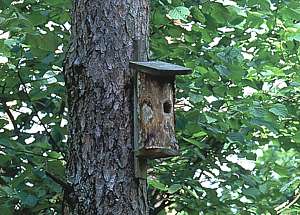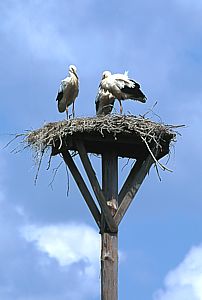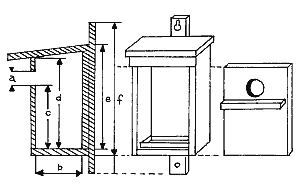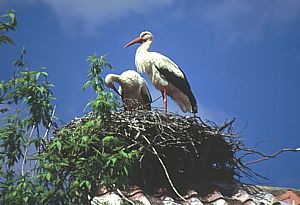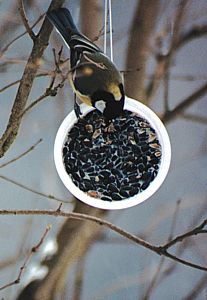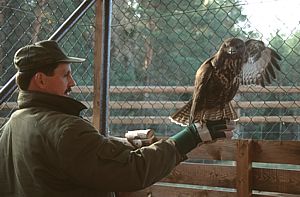|
BIRDS
|
|||||||||||||||
Text:
|
Bird protection
The relationship of man towards birds changed with the flow of time. At first birds were comparatively easily accessible source of food. Considerably later man began to value other advantages of birds, e.g. the skill of singing, which delivered to him aesthetical feelings, or the perfect abilities of hunting falcons, which were used in hunting. Today we pay our attention to the role birds play in nature - regulating the number of other animals, especially undesirable rodents or insects in the economy of man. Some species of birds are perceived by man as a threat for his economy, especially if they exist in a great number and do much considerable harm on fields, in orchards and in ponds. Not many species of birds became domesticated and are today one of the basic sources of food of man. It is difficult to overestimate the role of birds in natural environment and in the life of man. If we want to recognize dependences between birds and their environment of occurrence more precisely there has been conducted much research for many years over the biology and ecology of this groups of animals.
The science dealing with the research of birds is called ornithology. The results of research conducted during the last years show the quickly falling number of many species of birds. Changes, which man calls out in nature by his own activity, cause getting worse conditions of existence of many species of animals, including birds. Some species of birds were found on the so-called red lists of animals which are dying or are in danger of extinction or in red books of animals. To save the animals from extermination man is today forced to conduct the number of protective interventions aiming to improve the conditions of existence of birds.
Wigry National Park has been conducting the active protection of birds and their habitations for many years. This protection relies on hanging out and annual dry-cleaning of the breeding shelters installing the platforms for nests of white storks, creating the protective zones round the nests which are in danger if extinction, protecting the belt of reeds on lakes (the place of occurrence of numerous water birds) and giving the additional food for birds.
The breeding shelters are hung out in places where there are no natural places to install the nests. Practical shelters are of different size of inflow opening, which determines the species of bird to live in the shelter. Except shelters for such birds as: tits, sparrows, flycatchers, redstarts and nuthatches there are also shelters for water birds - goosanders and golden-eyes. After the end of breeding season the shelters should be opened and cleaned up in order to remove the remainders of old nests and parasites.
Very good results are received by building the breeding boxes from hollow trunks of trees, such as e.g. birch. The little roof and bottom are made from
natural wood, waterproofed with the ecological conserving substance. Such hutch is very permanent and does not surrender to deformations under the
influence of atmospheric factors. Moreover, it composes well with the forest scenery - and it is settled by birds very willingly. The most commonly used
breeding shelters are of comparatively simple construction, differing from dimensions. Type A with the following dimensions a - 35 cm, b - 110, c - 150,
d - 225, e - 245, f - 400 cm, is settled by e.g. tree creepers; type B (a - 50, b - 130,
In order to protect the white stork there are made wooden platforms under the nests which are placed on the roofs of farm buildings and on the specially prepared columns. The large ones, so liked by birds, are often used by birds to build their own nests on the roofs of buildings. The nest, annually extended, reaches with the flow of time huge sizes and can weigh up to 1000 kg and it can cause a serious damage to the roof of building. In such a case the only method preventing the tragedy is to place the nest on the nearby column finished with a platform, which will stand the nest firm.
According to "The instruction of marking and protecting the positions of animals-species which are in danger of extinction" the direct regions of nests of, among other things, Haliaeetus albicilla, kite and Aquila pomarinaare ruthlessly switched off from human penetration. One must not make any changes including cutting out of trees and shrubs, raising of objects and installations and of other works having an influence on the protection of reproduction places and the places of regular stay of protected birds in the distance up to 200 meters from these places during the whole year, and in the period from 1 February to 31 August in the distance up to 500 meters from these places.
Giving the additional food for birds is not recommended in the Park area. It peculiarly refers to feeding the swans and ducks, which "tempted" with the additional food can change their own behavior and can stay longer on the Park's reservoirs, and in the winter period they are exposed to hunger and freezing. The only exception is giving the additional food of tallow and seeds, for small birds only, in the periods of strong frosts and prolonged winters.
In order to save the wounded and weakened birds the Park built a spacious aviary in Maćkowa Ruda where ill birds are periodically held awhile. Having received a professional medical assistance they are free to go and in special cases e.g. of permanent injury they are delivered to the nearest zoological garden.
All immediate interventions of protection of birds conducted by the Park are efficient to a small or large extent, however best effects are brought by the rationally driven policy of improvement of environmental conditions, e.g. leaving the hollowed trees in old forests, the protection of waters from dirt and pollution, leaving the birds alone in their breeding period.
If you find a dead bird with a ring or just a ring you should send it to:
Stacja Ornitologiczna Muzeum i Instytutu Zoologii PAN (Ornithological Station, Polish Academy of Science) ul. Nadwiślańska 108, 80-680 Gdańsk 40 tel. (+48) 58 308-07-59 fax (+48) 58 308-09-82 email: stornit@miiz.waw.pl or come into contact with Wigry National Park.
|
||||||||||||||
|
|
|
